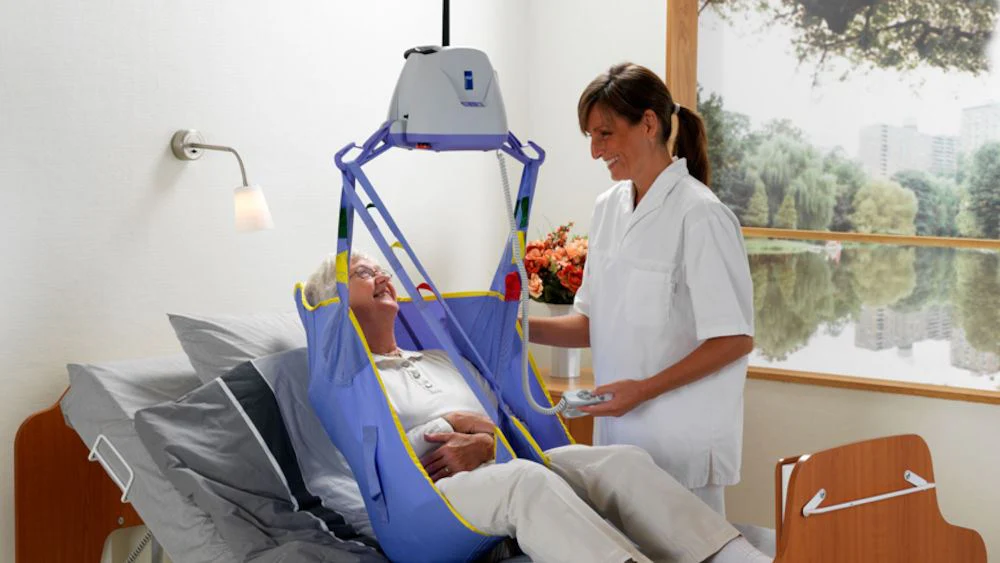Useful Advice for Safe Patient Lift Use at Home
Like wheelchair ramps as well, patient lifts are crucial equipment for caregivers. They provide a safe and effective way of helping those with limited mobility. The equipment improves accessibility and safety of caregiving, thereby benefiting both the patient and caregiver. But it should be properly used to avoid accidents or injuries.
In this article, we will provide the most important tips to ensure the safety of lifts for patients within a home environment.
Receive Proper Training
Knowing the model you are using and its characteristics, as well as its limitations, is essential. Different types of patient lifts perform differently; therefore, having a good understanding of their operation is crucial to ensure safety. Numerous manufacturers and healthcare professionals offer educational sessions or videos that are extremely helpful. If you have doubts regarding the lift, you should seek additional information or training.
Focus on Patient Safety
Before every use, assess the health of the person and any particular needs. Examine their health and take note of any injuries or concerns that might affect the lifting. Following this, pick the right type of sling, ensuring that it is fitted correctly, as an unfit sling can cause injury or discomfort.
Securely and comfortably in the sling while making sure to look for any pressure points or indications of discomfort. While lifting, make sure to consider their comfort and security.
Get Acquainted With the Lift’s Controls
When using the controls, it is essential to move gently and slowly to avoid abrupt movements that could result in injury or discomfort. Doing a few exercises with an empty sling before working with patients is an excellent method of getting familiar with the controls as well as the lifting functions.
This exercise will boost your confidence and abilities by ensuring that you’re equipped to lift safely in the presence of the help of a person.
Look for Correct Body Posture and Movement
Caregivers should take note of their body mechanics to avoid injury while using the patient lift. Set your feet about shoulder width apart, with your knees bent, and ensure that you have a straight back. While using the equipment, be careful not to twist your body, since it increases the chance of injury or strain.
Instead of relying on your back, utilize your legs to lift. A good body mechanics routine can protect you from injuries and assist in maintaining balance, increasing your overall security during your operation.
Make the Lift on a Stable and Even Surface
Unstable or unstable surfaces can affect the safety of the lift and reduce maneuverability, increasing the risk of accidents. Before you operate the machine, make sure you ground level.
Also, make sure that the area around it is free of any obstructions that could hinder mobility or create dangers for tripping. A clean and solid environment is vital to the safety of the lift’s operator and for the security of the patient and caregiver.
Involve the Patient While Using the Machine
Before you begin the process, you should explain each step to your patient. Clear explanations help them be aware of what they can expect and help promote calm, which will reduce the chance of sudden movements that may disrupt the lifting process. Communication should be open to allow the patient to speak up about any issues or discomforts so you can address the issues promptly.
Always Use the Lift Within Its Specified Weight Limit
The patient lifts are designed to operate within a specific weight range. Overstepping the limit could lead to the breakdown of the machine and even serious injuries. It’s essential to be aware of the weight limits of the lift and ensure that the user’s mass is within the specified range. If the weight is greater than the capacity of the equipment, you should consider different methods for lifting.
Get Extra Help When You Can
Incorporating other people will significantly enhance the safety of your lift. Two people are using the lift, while an additional person assists the patient to help the whole process go more easily. This technique reduces physical strain on the primary caregiver and allows for more control during the lift. It’s essential to coordinate actions with your assistant for a smooth as well as safe lift experience.
Practice Emergency Procedures
Whatever you prepare, emergencies can still occur. It is essential to be prepared and to be able to execute emergency protocols frequently.
Learn the best ways to help a patient to a lower position when there is a power failure or a breakdown in the equipment. Learn the manual operation for the lifting device, and also the features for emergency reduction. Through constant review and practice of these techniques with your fellow caregivers, all caregivers will be prepared to be able to react effectively in the event of an emergency. This increases safety overall and offers assurance.
Check the Equipment Frequently for Signs of Wear and Tear
Check all the components of your lift, including the sling and base, for signs of wear or damage. If you notice any damaged components, replace them immediately to prevent failures. It’s also important to follow the maintenance schedule provided by the manufacturer because routine maintenance can keep minor issues from developing into major issues.
Conclusion
Utilizing the guidelines in this article can greatly improve the safety and efficiency of lifting patients at home. A thorough training program, attention to the comfort of the patient, and regular maintenance of the equipment are essential to keeping accidents from happening and guaranteeing an efficient lifting process.
If you are in need of a premium patient lift or would like to know more about alternatives for mobility equipment, get in touch with a reputable mobility aid vendor. Investing in the right equipment will not only aid in your efforts to care for others but will also enhance your quality of life those you love. Start the next step to safe handling of patients now!



